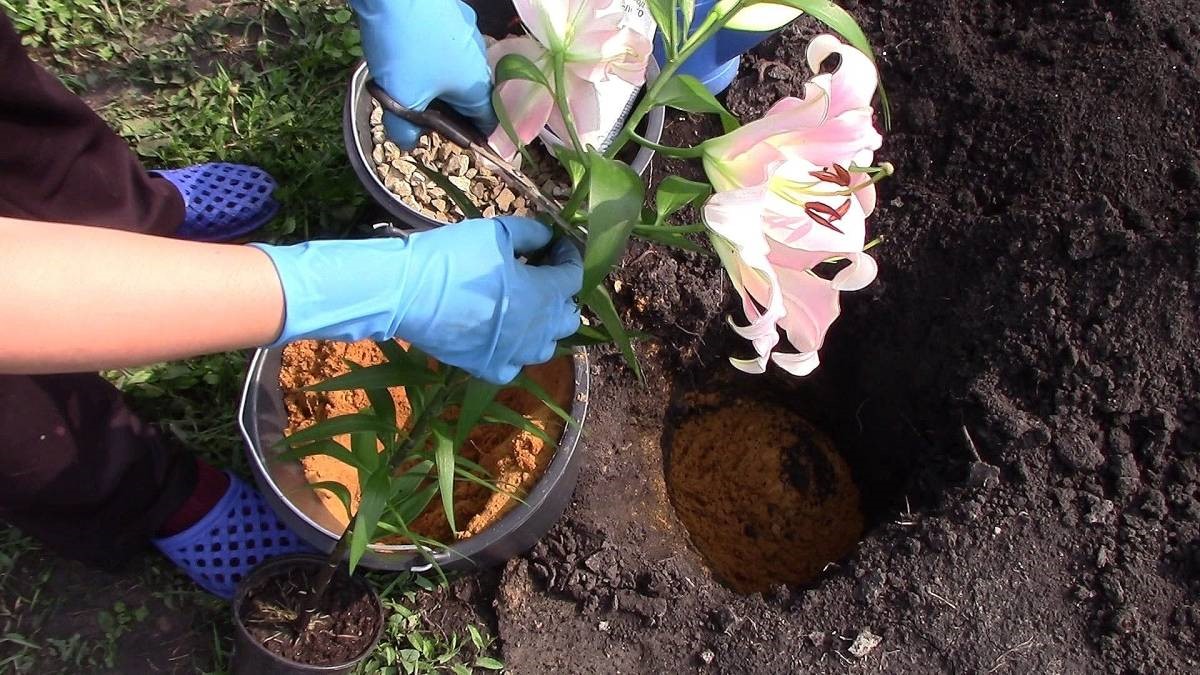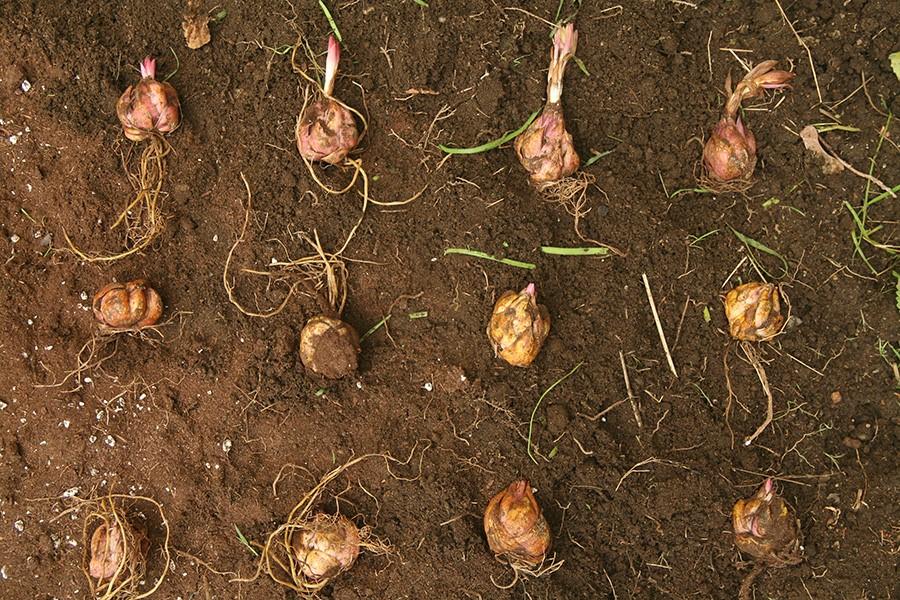Content
Lilies have captured the hearts of hundreds of thousands of gardeners. An ornamental plant looks great around the site and makes you look at it. Even beginners rarely encounter problems with growing crops. Planting lilies in summer, spring or autumn depends on the gardener’s preferences. The procedure can be carried out at any time if you study the nuances of the work.
Preparing for landing
Before planting, you should familiarize yourself with the characteristics of your variety. Some varieties are difficult to plant in summer. This is easiest for the Candidum variety and oriental hybrids. When purchasing seedlings in June or July, you need to understand that before the sale, the plants grew in greenhouse conditions. In open ground, the crop will bloom in 2-3 years and will get sick more often.
Bulb selection
The first thing to do is select the bulbs. In this case, they focus on the appearance of the material: the presence of inclusions, traces of disease, growths. Preference is given to large samples with healthy skin.

To obtain viable material for planting, the buds are cut in late spring or summer - at an early stage of formation
The bottom must be clean. A damp bulb indicates the appearance of rot. When choosing raw materials in a store, it is important to touch each lily. It is good if the plant is elastic and has a fleshy base.
To prevent lilies from spoiling, they are purchased shortly before planting. By that time, you need to determine the location and process the area. Samples cannot be stored in polyethylene, since the bag does not allow air to pass through - it promotes the accumulation of moisture and, as a result, rotting.
Therefore, the culture is placed in perforated packaging and placed in the refrigerator. Lilies begin to germinate during long-term storage. When the first symptoms appear, the material is removed from the bag and placed on the table.
It is important to look at the country of origin. Dutch lilies are pre-treated with fungicides and insecticides - they do not require additional spraying. If the bulbs are from Russia, they are probably not treated with anything. Before purchasing, it is better to check with the seller for details.
When lilies are in the refrigerator for more than half a month, they need to be disinfected from fungi. After storage, the raw materials are washed and immersed in a solution of potassium permanganate for 30 minutes. In a similar way, you can use the drug Maxim or Fundazol.

In summer, it is easier to control the planting of lilies in a pot, but the garden soil needs to be pricked in the oven
After soaking, drying is carried out. If the spring deadlines are missed, plant in the summer. 24 hours before work, the bulbs are treated with Epin.
Site selection
The choice of location determines how luxuriantly the plants will bloom. Lilies are comfortable in open spaces, protected from frequent rainfall and strong winds.A bad choice would be a wet area with a high level of groundwater - lowlands, ravines. In summer, rain moisture also stagnates in them.
Soggy soil becomes a breeding ground for fungal spores and insect larvae. Being in it, the plantings will often get sick and freeze closer to winter.
If the owner could not find a place, you can purchase a flower bed. When planting lilies near a fence, at least 60 cm should be removed from the fence. Otherwise, rainwater will flow directly to the bushes.
Botanists do not recommend placing plantings in the shade - near a high fence, trees, or walls of a house. Lack of lighting will affect the diameter of the buds. They become thinner and thinner, and this will also affect the immune system.
Soil preparation
Bulbous plants are demanding on soil composition. Heavy soils are a poor option for planting. It will be difficult for the roots to squeeze through, which will slow down metabolic processes. In this case, it will be difficult to avoid moisture stagnation. Therefore, they select a place with looser soil and cultivate it a week before planting.

The best time to plant lilies is autumn; if time has been lost, it can be done in the summer, but the likelihood of success will be lower
The best time to plant lilies is autumn; if time has been lost, it can be done in the summer, but the likelihood of success will be lower
If the area is acidified, add chalk or dolomite flour. Regardless of the quality, the soil is dug up. The shovel is deepened by 40 cm, weeds and household waste are removed.Within a week, the soil should have time to warm up and accumulate moisture.
How to plant lilies in summer
You can plant lilies in open ground in summer, spring or autumn. The technology depends on the form in which cultivation is planned. The plant can be propagated using flowers, sprouts or bulbs.
Planting lilies with flowers
The advantage of this method is that the owner can choose the right color and make sure the lilies are healthy. This is difficult to do with bulbs, as they hide the symptoms of diseases. The latter appear as they grow.
In order not to injure the crop during replanting, in the summer they carefully dig up the roots and clean them from the ground. The pot should be spacious enough. A hole is prepared in open ground. The depth for lilies is 6 cm greater than the height of the pot. The bottom is fertilized with superphosphate.

After planting in the summer, it is better to mulch oriental varieties with sawdust; for snow-white lilies, peat mass is more suitable
After planting, water well. In summer, the owner will have to moisten the soil frequently. A dense crust should not be allowed to form. Only in this case will lilies quickly adapt. If the work had to be postponed until July, the inflorescences are cut off, this will allow the nutritious juices to be directed to strengthen the roots. In addition, next year the crop will form more buds.
Planting lilies with sprouts
The presence of sprouts indicates that the plant’s vegetative cycle is disrupted. Raw materials can be planted in open ground, but they will have less chance of surviving the winter. By the time cold weather arrives, the bulb will not have time to germinate sufficiently - flowers will appear in a year.

In summer, even with frequent winds, lilies do not require garter, so after planting they concentrate on the frequency of watering
If the sprouts are at an angle, the bulb is planted so that they are directed exactly vertically. The lily will change the direction of the roots and growth will proceed as it should. Otherwise, the planting technology is similar to bulbs without sprouts.
Planting lilies with bulbs
The raw material is deepened into the ground to a distance three times its size. In loose soil you can make the hole a little larger, in heavy soil - more compact. At the same time, varietal characteristics are also taken into account. For example, if a bush is tall, it needs more space than a dwarf one.

After planting in the summer, lilies are mulched - the procedure is mandatory to prevent rotting and warm the bushes
Planting is carried out according to one of the following schemes:
- Three-line. Gardeners use it to grow dwarf lilies. A distance of 10 cm is maintained between the material, and 30 cm between the lines. The ribbons are placed at a distance of 70 cm.
- Two-line. It is used for medium-sized varieties. The distance between the bulbs should be at least 15 cm. The distance of the ribbons and stitches is similar to the three-line planting.
- One-line. Leave 50 cm of free space between the lines, and 5 to 10 cm between the lilies.
At the bottom of the pit there should be a layer of sand (5-7 cm), which is sprinkled with earth and moistened.
Further care
Lilies definitely need care. If you leave the crop, it may survive, but it will not produce lush flowering. Moisten as the top layer of soil dries. At the same time, the frequency of precipitation and air temperature are taken into account, and in the summer they water regularly.
Excess liquid will cause lilies to rot, so it is advisable to use mulch.This is especially true for OT varieties, because their roots also form above the bulbs. If the roots are exposed, there is no need to worry - just dig them in again.
The optimal time for watering is morning. By evening, the foliage should dry out so that the plant does not feel cold. Lilies do not like organic fertilizers, so they add mineral complexes. In summer they are fed without fail. Potassium and magnesium will help improve the brightness of the petals.
If you plan to make a bouquet of lilies, the peduncle is left in the flowerbed. It is necessary for nutrition. The cut area is treated with a disinfectant, for example, medical glue. Flowers are removed immediately after wilting. In the fall, cut off the stems, leaving 10 cm sections in the ground. After the leaves fall, the flowerbed should be insulated.

Planting is only half the battle; for lush growth, lilies need to be fed regularly; in summer, nitrogen is used with caution
In the middle zone, the shelter is made of peat or spruce branches; dry leaves can be used. Residents of the Moscow region additionally cover the area with film. It is removed in the spring - it is important not to miss the moment so that the crop does not rot in the summer.
Bulbs can be planted in any season. The main thing is to familiarize yourself with the characteristics of your variety, know the acidity of the garden, and the nature of the soil. Any soil can be adjusted in the desired direction. With proper care, the lily adapts without unnecessary stress.
Conclusion
To plant lilies in the summer, follow the correct technology. The material is checked for viability, the site is selected and prepared. Depending on the wishes of the gardener, flowering may take place next year or not at all.








